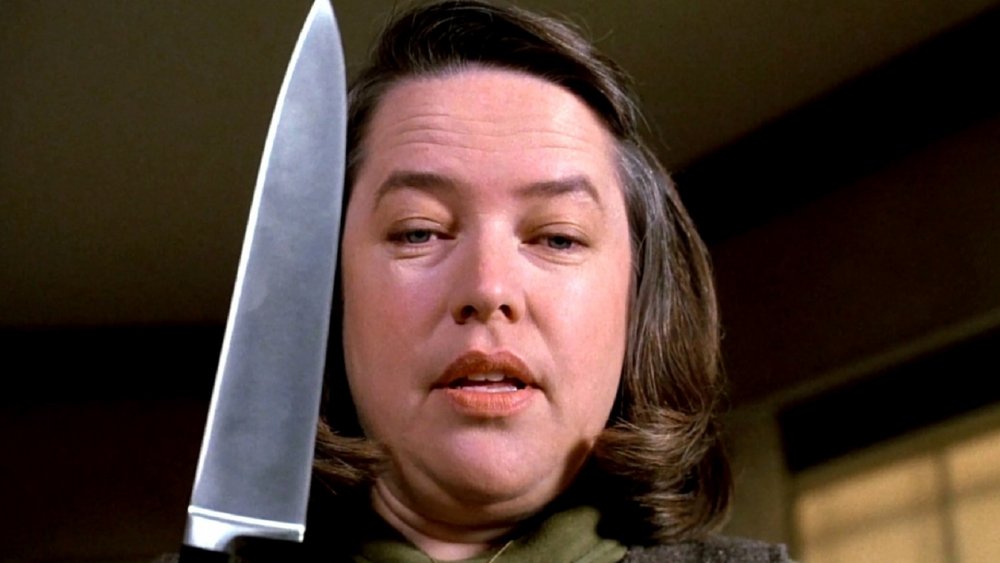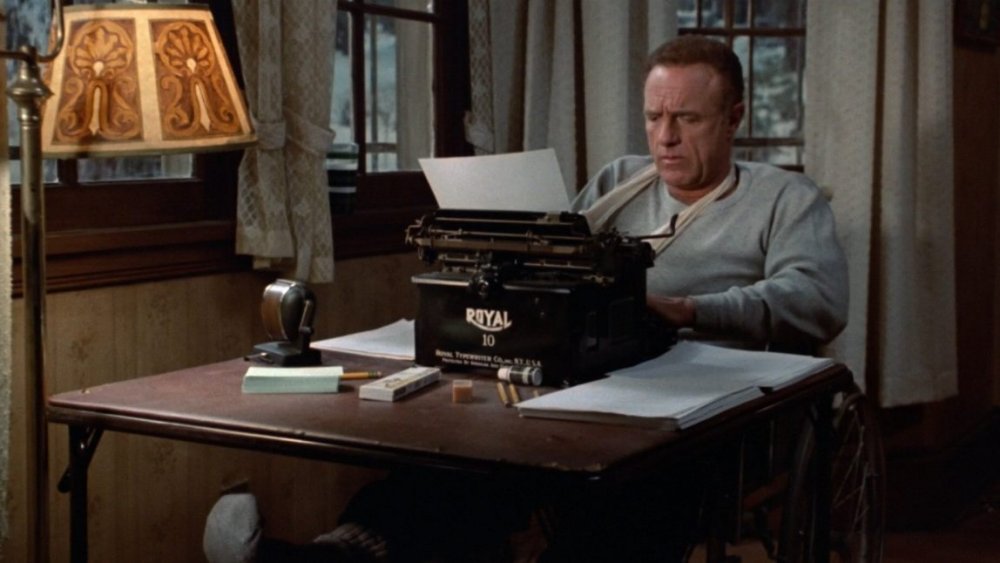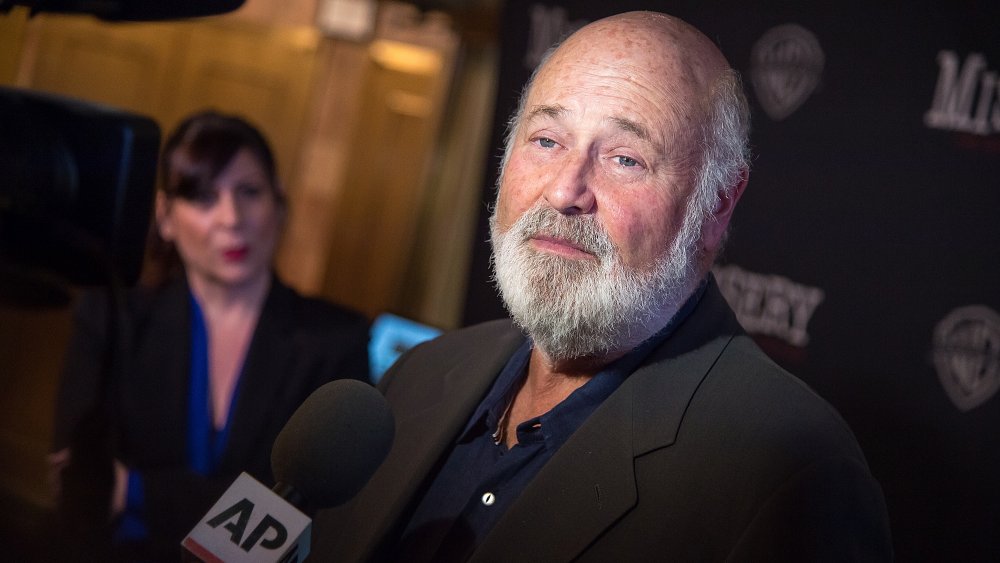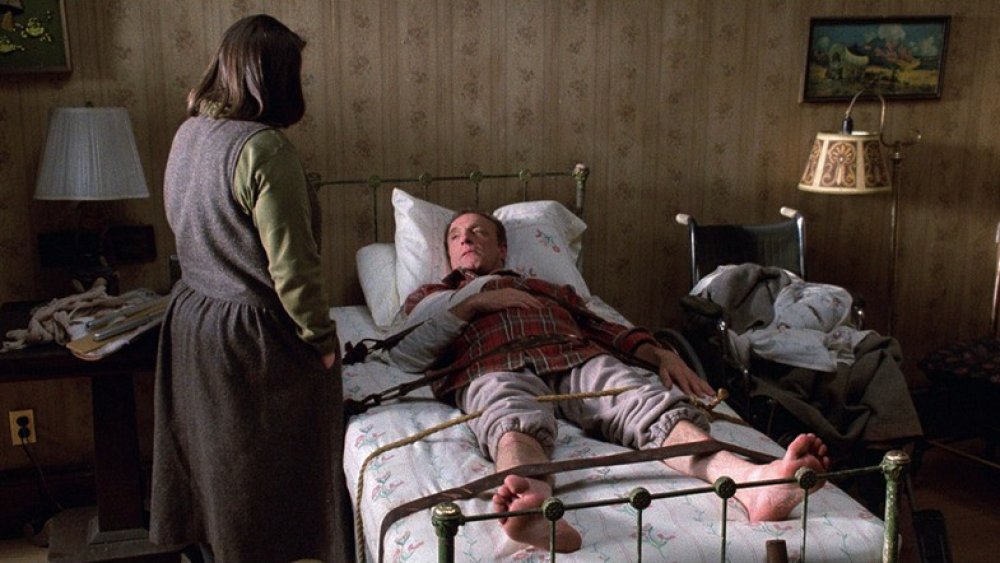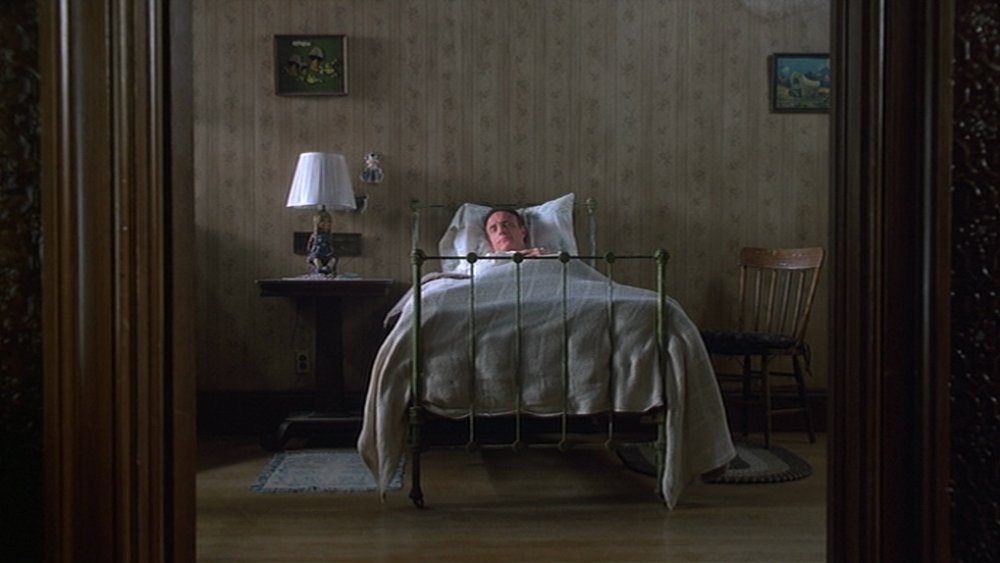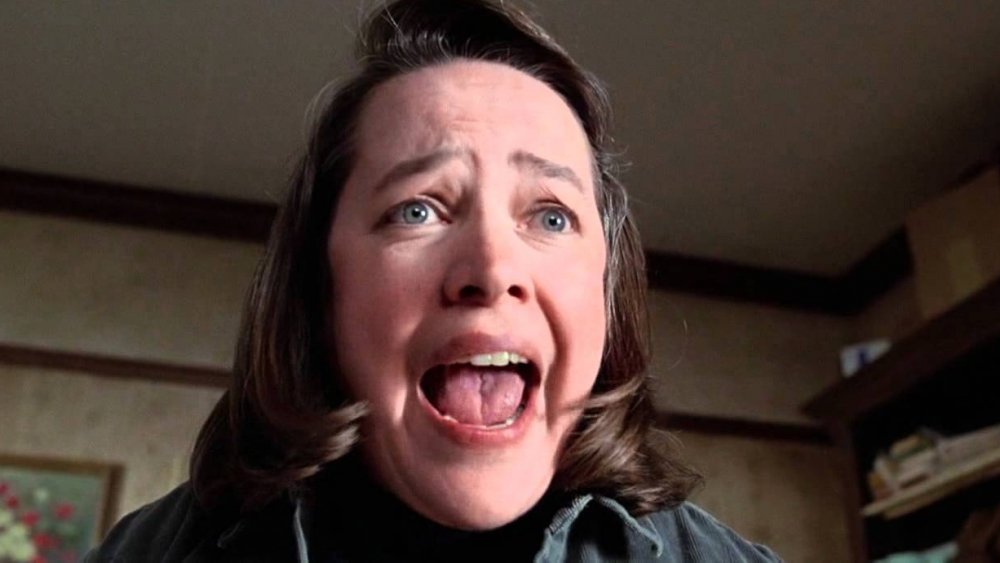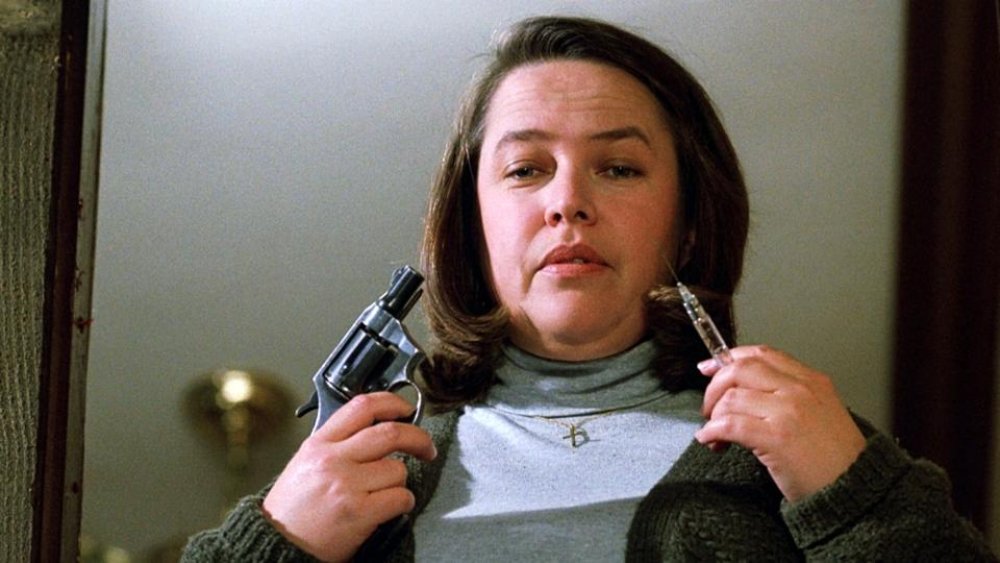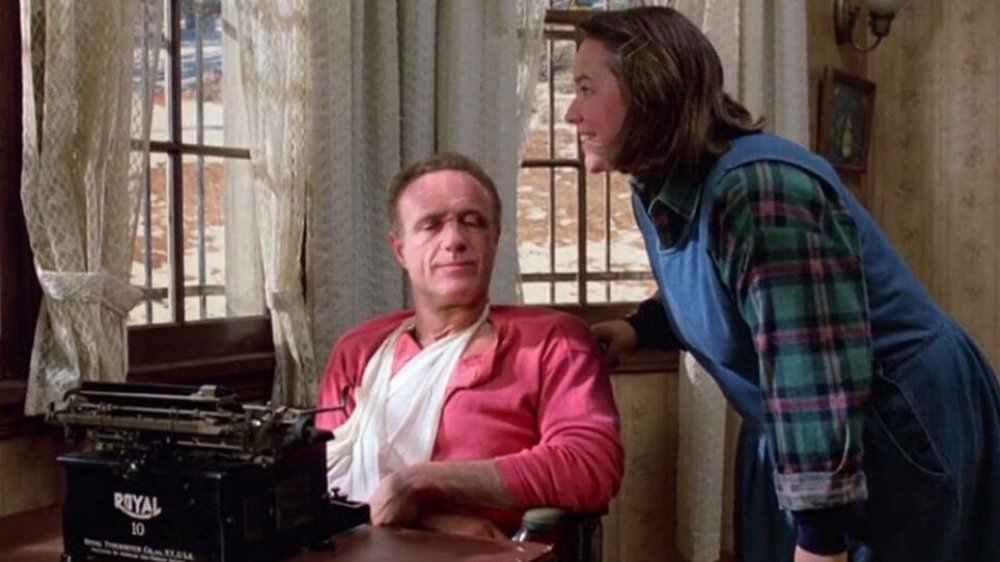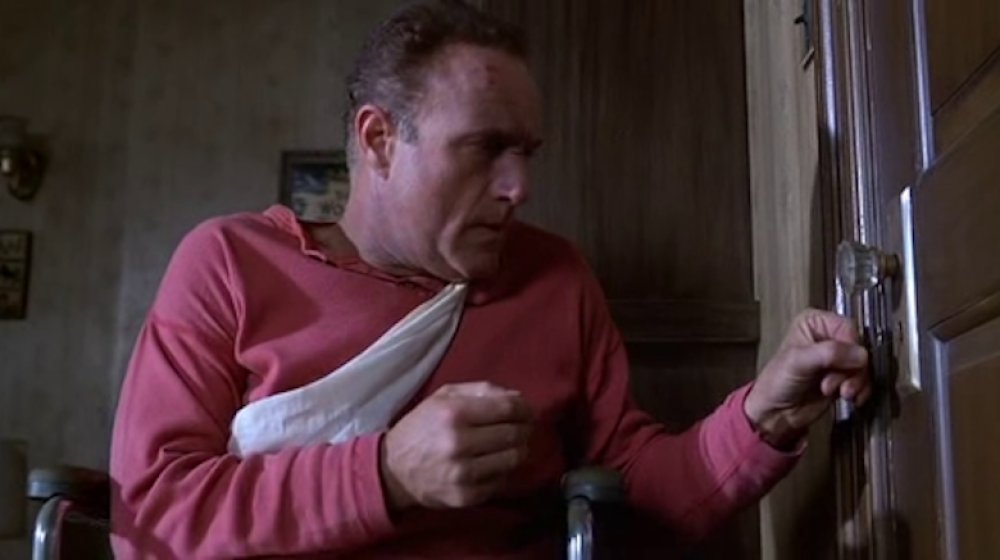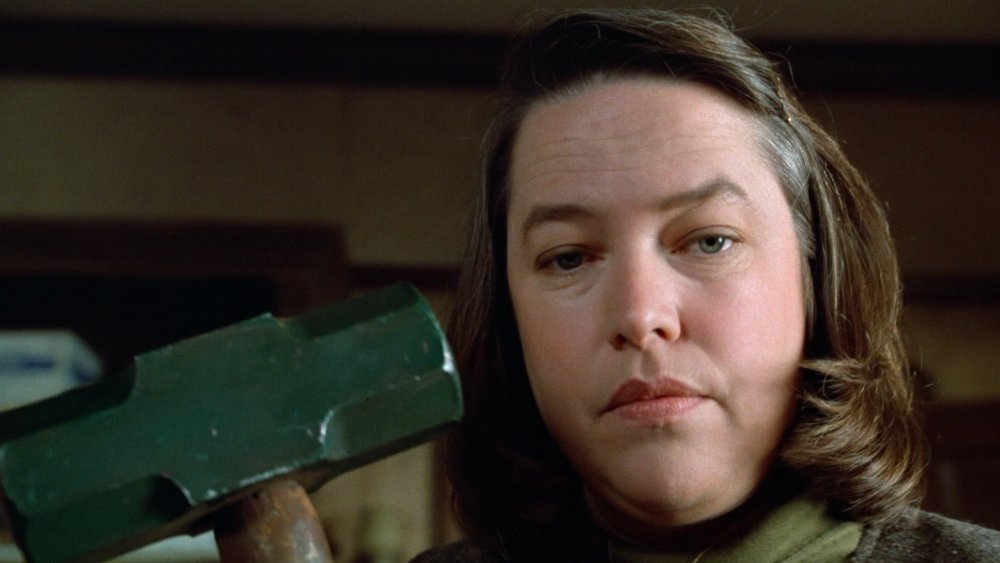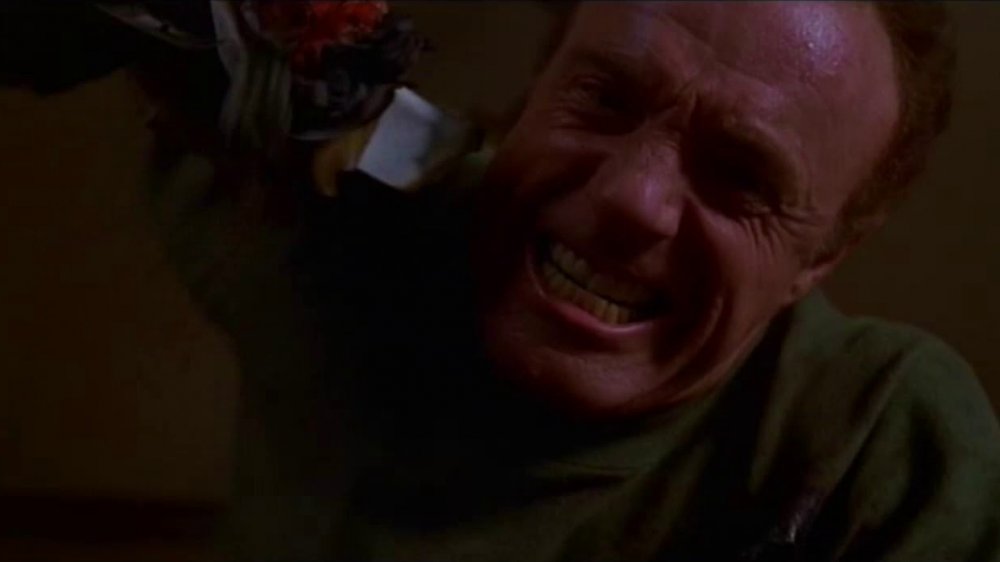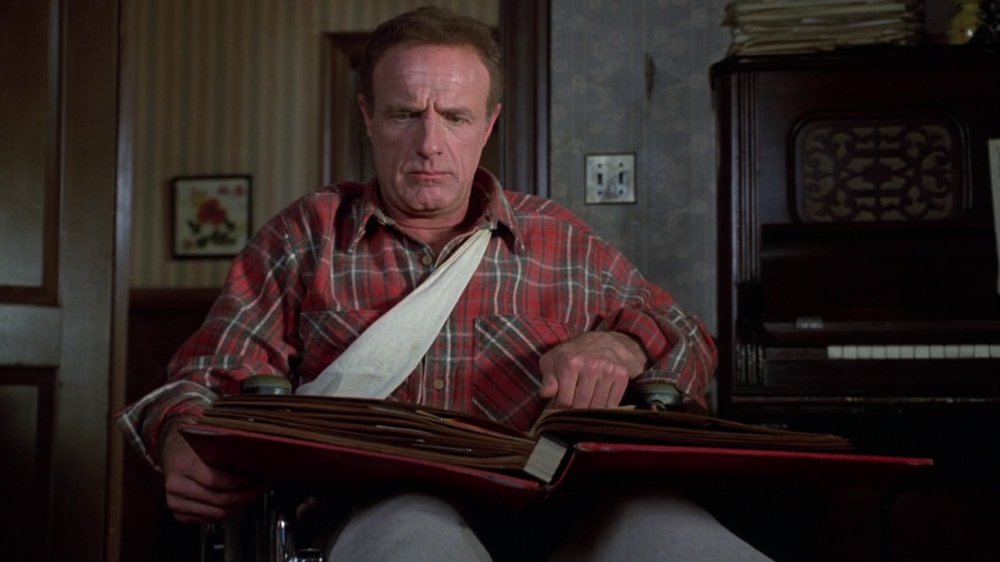The Untold Truth Of Misery
"I'm your number one fan," Kathy Bates intones as mercurial Annie Wilkes in Rob Reiner's 1990 hit Misery, and as quick as she said those five seemingly innocuous words, they went down in horror history as some of the scariest ever uttered. Based off Stephen King's novel of the same name and a parable about drug addiction, Misery follows bestselling romance novelist Paul Sheldon (James Caan) after a terrible snowstorm car accident leaves him holed up in Annie's secluded home ... and she has no intention of letting her favorite author of all time go. When she finds out that Paul has killed off her favorite character, Misery Chastain, for a gritty attempt at a "serious" novel, the horror mounts exponentially as Annie forces Paul to bring her beloved Misery back.
Misery was Kathy Bates' first leading role, as well as her first Oscar nomination and win for her marvelous and nuanced turn as a woman on the edge who pushes herself over. Then-Hollywood bad boy James Caan followed through with a redemptive performance that still resonates today, and Rob Reiner's horror-thriller debut secured itself as one of the horror classics of modern film history. Hulu's Castle Rock explored Annie Wilkes' backstory in 2019, but the 1990 adaptation still remains iconic. From the could've-beens to the film's unique production style, here's the untold truth of Misery.
(Be warned — there are some spoilers below.)
Misery would've looked very different with alternate casting choices
In one of the more unexpected casting choices for the story about a crazed fan who kidnaps her favorite author, the role of Annie Wilkes was originally offered to film and Broadway star the Divine Miss M herself, Bette Midler. While Bette Midler has played a wide range of roles over the course of her career, frumpy and hyperbolic Annie Wilkes still would've been an surprising performance to add to Midler's esteemed catalog. Because the version of the Misery screenplay Midler read followed the foot amputation of King's book, when talking to The New York Times, Midler confessed she turned down the role simply because she didn't want to do this scene. She later called the decision "stupid," especially since the role went on to win Kathy Bates an Oscar. In fact, screenwriter William Goldman actually wrote the movie specifically with Kathy Bates in mind, having been a fan of hers on and off Broadway, so not everyone was upset when Midler passed on Annie.
While there were only two women in the running to play Annie Wilkes, a veritable who's who of male Hollywood stars were offered the role of Paul Sheldon, who was a well-known author in the story so he needed to be a recognizable face. Robert Redford, Harrison Ford, Michael Douglas, William Hurt, Dustin Hoffman, Robert De Niro, Al Pacino, Richard Dreyfuss, Gene Hackman, Kevin Kline, and Warren Beatty all turned down the part. James Caan, who'd been struggling personally and professionally, eventually agreed to the role as part of his comeback to the Hollywood machine.
Warren Beatty had a hand in the character development
Being one of the most sought-after actors at that time, Warren Beatty was at the top of the casting list to play Paul Sheldon, and he was also one of the few actors who was actually keen on possibly starring in the film in spite of its gruesome violence and creepy themes. As Beatty was in discussions about the role, director Rob Reiner told the Los Angeles Times that Beatty had even offered him and William Goldman a few suggestions on how to make the character "less passive," which the production team ended up integrating into the final screenplay.
But when it came down to brass tacks, Warren Beatty ended up having to ultimately pass on Misery because of scheduling conflicts with his film adaptation of the Dick Tracy comics that he ended up directing, as well as starring in. Funnily enough, eventual Paul Sheldon actor James Caan has a small role in Dick Tracy, too.
Rob Reiner was the only director Stephen King trusted with Misery
Stephen King's novels are deep and expansive, often with huge casts of characters, all of whom have rich internal lives that King explores through each individual. This makes successfully adapting King's stories to the screen — his novels in particular — a singular challenge, and very few directors even today have accomplished this Herculean feat. However, when Rob Reiner took on the adaptation of King's memoir novella The Body, he made a number of editorial changes that removed the more grotesque and horrific aspects of the story, making Stand By Me into a beautiful coming-of-age film that has also stood the test of time.
Talking to the LA Times, Reiner said, "[King] told me it was the best film that had been done from his books. Before I could get too excited, he quickly added, 'But that isn't saying very much.'" As Reiner and his production company decided they'd like to approach King about adapting Misery, they found out that King had denied a number of requests because he was so tired of mediocre (or downright awful) adaptations. But with Reiner's name in the mix, King handed over Misery to the director's accomplished hands. To this day, Misery remains one of King's favorite film adaptations, and he was super into the first screening of the film.
Rob Reiner looked to Alfred Hitchcock for inspiration
Rob Reiner may have been a Hollywood staple both on the screen and behind the camera, from All in the Family to The Princess Bride, but Misery was still his first horror film, and he had to learn as he went, looking to cinema legend Alfred Hitchcock for inspiration. Reiner watched and studied every Hitchcock film, a sensibility that's clear when watching Misery again with this knowledge in mind. Hitchcock often had feature films with small casts working in close spaces, and this was the exact setting of Misery. From framing to pacing, Hitchcock's touch is all over Misery through Reiner's hands.
In particular, Reiner tried to capture the tension of Dial M for Murder while loosening up on the claustrophobia factor whenever he could, like with bringing the thoughtful sheriff (Richard Farnsworth) and his no-nonsense wife (Frances Sternhagen) into the mix. In fact, Reiner was so fixated on how Hitchcock would've done things that James Caan overheard him berating himself on numerous occasions, saying, "Who do you think you are? Alfred Hitchcock?" Rob Reiner might not be Hitchcock, but he left an indelible mark on horror movie history with Misery regardless.
Reiner made Caan actually stay in bed, even between takes
While filming Misery, Rob Reiner treated the whole thing like a play, sort of like Alfred Hitchcock would, which meant he decided to ramp up the tension and frustration by not allowing James Caan to get out of bed and blow off steam between takes. Talking to the LA Times, Caan admitted, "I sometimes wondered if this was a sadistic joke on Rob's [Reiner's] part. You know, 'Let's get the most hyper guy in Hollywood to stay in bed for 15 weeks.' ... I was doing something I'd never done. For me, this being a totally reactionary character is really much tougher."
Even though this was physically and emotionally uncomfortable for Caan, it added an incredible level of realism to his performance as a badly injured and quickly drug-addicted Paul Sheldon. It's also worth noting that Hitchcock similarly "tortured" actors during his films — such as his abuse of Tippi Hedren during The Birds and Marnie — but for an entirely different endgame that ironically involved the kind of control scenario the character of Annie Wilkes created in her home.
Reiner and Bates came up with an original backstory for Annie
The character of Annie Wilkes as written by Stephen King is as enigmatic as she is monstrous. For example, when Paul briefly escapes his room, he finds a scrapbook that suggests Annie has been murdering people for a long time through her work as a nurse and caregiver. But the book doesn't explain why she committed these heinous crimes. As a stage actor, Kathy Bates had always done significant character development work to make sure she knew every facet of who she was becoming, and Misery was no different.
According to The New York Times, Rob Reiner and Bates worked together to come up with an original story for Annie's past that involved her having been physically and sexually abused by her father as a child in order to explain why she ends up killing babies and older folks. But in spite of this character work off-screen, Bates' performance as Annie Wilkes is so commanding that it's almost scarier that we don't exactly know why Annie takes all of her violence so far. But Bates still managed to humanize her, which is why she took home an Oscar for this nuanced portrayal.
Playing Annie Wilkes was incredibly emotional for Kathy Bates
The thing about villains is that to themselves, they're the heroes of their own stories. So as Kathy Bates developed Annie Wilkes' background and sorted through all of her motivations, the woman was no longer as straightforward a monster as she appears on-screen. At least not to Kathy Bates. What did this mean for the production, though? Kathy Bates was often on set crying before scenes because she was so overwhelmed by everything Annie was going through and the sadism she felt forced to enact on her most favorite person in the world. In particular, before the hobbling scene where Annie breaks both of Paul's feet to prevent him from escaping again, as well as their ultimate showdown, Kathy Bates was veritably inconsolable before pulling her emotions together for filming.
Speaking with Today, Bates said she found the levels of violence directed at her in particular during the final confrontation a lot to handle, and Caan has also noted that Kathy Bates was an extremely anti-violent person in general, so she had to go to quite a dark side for Misery. Interestingly, as the years have passed by, Kathy Bates has made a number of other excellent horror outputs, in particular as her multi-character run on American Horror Story where shades of Annie Wilkes regularly pop up.
Kathy Bates and James Caan came from different acting backgrounds
While James Caan was a well-established movie actor by the time they made Misery, it's almost hard to believe now that the film was actually Kathy Bates' first leading role. Because it was her first starring part in a movie where she would be one of two people on the screen virtually the entire duration, Bates brought her theater training in with her as it pertained to Annie's character development, as well as rehearsing scenes multiple times to make sure she got it all right and then trying to maintain that energy while the camera was running.
But as a veteran screen actor and reactionary, Caan preferred the improvisation that can come with camera work, and he didn't want to rehearse. Rob Reiner told The New York Times, "Kathy kept saying, 'Jimmy's not relating to me, he's not listening to me. I said, 'That's true, he isn't. His character doesn't care one iota about yours. You can use that to fuel your rage.'" While this did fuel aspects of Bates' performance, this dynamic still made her feel extremely isolated on set, a feeling that she began to take home with her after filming wrapped until Reiner sat her down and reminded her to leave the character at the door outside of work.
James Caan had very unusual marks for blocking
For most of Misery, Paul Sheldon is in his bed or in his writing chair, generally looking miserable and in terrible pain. But there is one heart-pounding scene when Annie leaves Paul alone, and thanks to a bobby pin he'd secreted away, he manages to get out of his bed and into Annie's house beyond to spy. Incredibly, there were no stunt doubles used for James Caan's many falls out of the bed, and it's he who drags himself into the wheelchair without the support of his legs. While there were some discreet marks on the floor to help Caan with the blocking of the scene as he pulled himself across the floor, they didn't end up being sufficient.
So, future Men in Black director Barry Sonnenfeld, the lead cinematographer for Misery, spit a mark onto the floor and rubbed it in. "When you feel a certain dampness, Jimmy, just stop there," Sonnenfeld deadpanned, as Reiner cracked up responding, "Right. Stop at the schmutz." Caan admitted to eventually finding the gag funny, but seeing the intense scene they were about to film, the prank probably could have waited.
The hobbling scene went through axings itself
In King's original disturbing novel, after Annie Wilkes finds out her favorite author/kidnap victim has escaped his room and snooped around her house (including reading her murder scrapbook), she goes into a quiet rage. She tells Paul a story about slavery times and what masters would do to slaves who tried to run away, and then she proceeds to hobble Paul ... by cutting off his left foot and cauterizing the wound with a hot iron. It's visceral and horrific, and it was originally part of William Goldman's screenplay. However, this was an aspect of the movie that was scaring away talent, and it also felt over-the-top for such an intense character study as the movie was shaping up to be.
So instead, Reiner changed it to Annie breaking his feet, a scene that plays out just as viscerally as an amputation in the finished Misery product. Screenwriter Goldman was upset at the change at first, but he later agreed with the choice after he saw the final film, saying (via Yahoo! Entertainment) that an amputation would've been a step too far, and the disturbing point was still well made with a sledgehammer rather than an axe. Kathy Bates, on the other hand, remains annoyed by the change to this day. She had prepped her character based on this horrific act, so to her, the sledgehammer didn't pack the same punch, so to speak.
Practical effects make Misery stand the test of time
In spite of the fact that Misery is essentially a two-person show that heavily relies on inter-character interactions and dialogue rather than action, there are still several scenes that put the thrill into this thriller, namely the hobbling scene and the brutal, final confrontation between Paul and Annie. But according to Yahoo! Entertainment, there were no stunt doubles used in Misery for any of this. That's right. Kathy Bates swung the axe herself onto a prosthetic set of legs, under which James Caan's legs were safely unharmed. And Bates and Caan did their entire fight scene themselves, with only a few prosthetics needed for Annie's head as Paul eventually defeats his captor, killing her.
Misery's use of practical effects in these regards are among the many aspects of the movie that have withstood the test of time. It's even more impressive now realizing that Kathy Bates and James Caan literally went head to head in person. Even decades later, that fight is a nail-biter, and it looks so real because it actually kind of was.
James Caan struggled with alcohol abuse on set
James Caan was at the bottom of the casting list for Misery for many good reasons, the biggest of which were his substance abuse problems that eventually led to severe financial troubles, along with great personal loss. For a time, he was a Hollywood pariah that nobody would touch, which, funnily enough, ended up making him the perfect face for a sellout romance novelist trying to turn his career down what he considered to be a more legitimate path.
While Caan had claimed to clean up his act for this important movie comeback, he still came to work one day so hungover that the entire day's worth of filming was unusable and needed to be reshot. According to Caan (via Page Six), Reiner covered for the actor, saying there had been issues with the film lab. But when Caan found out the real reason for reshoots, he was so mortified that he actually offered to pay for the time wasted and didn't do it again.
Screenwriter William Goldman adapted Misery to Broadway
In 2015, Misery screenwriter William Goldman adapted his scary script to Broadway, a move that made a whole lot of sense given the claustrophobic nature of the movie, as well as its limited and intimate cast setting. The Misery play ran for just over a year, and it starred none other than Bruce Willis as Paul Sheldon and the queen of crazy eyes herself, Laurie Metcalf, as the inimitable Annie Wilkes.
While the production value and the performances earned some mild kudos, the stage adaptation was said to have lacked the tension and underlying fear of the film, resulting in more pity than horror in the end, especially without a nuanced performance from Willis to heighten the stakes. But in spite of lukewarm reviews, horror fans and Misery fans in particular still would've enjoyed seeing this new take on an old, creepy favorite.
